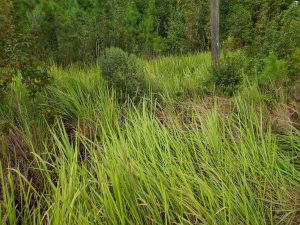Over the last decade or so, the Panhandle has been overrun, and I don’t just mean by the summer beach traffic. Rather, by an aggressive, exotic perennial grass that quickly displaces all native species, is not useful as a forage to wildlife or livestock, can spread by roots or seeds, and has no natural enemies. If you own property in the Panhandle or spend any amount of time on its roads, chances are you have become acquainted with this worst of invasive species, Cogongrass (Imperata cylindrica).
A native of Southeast Asia, cogongrass was introduced into the US in 1912 around Mobile, AL as a hitchhiker in orange crate packing. Then the 1920s, 30s, and 40s, it was intentionally introduced from the Philippines into other Gulf Coast states, including Florida, as a potential pasture forage for livestock. Since then, cogongrass has become one of the most economically and ecologically important invasive species in the US and worldwide, infesting nearly 500 million acres and is now found on every continent.
Cogongrass is easily identified in late spring, when the grass throws easily spotted fluffy, white-colored seedheads above the mats of grass beneath. Additionally, patches of cogongrass are almost always noticeably circular in nature, radiating out indefinitely from the initial infestation. A closer inspection of the grass will reveal light green leaves up to 4’ in length, with an off-center, silvery colored midrib (the primary leaf vein that runs from the base of the leaf to the tip) and serrated leaf edges. Underground, cogongrass exhibits a dense underground root system that can reach as deep as 4’. This feature is the primary reason cogongrass outcompetes other plants, withstands any drought, fire, or soil condition thrown at it, aids in its resistance to herbicide activity, and generally makes it very difficult to manage.
The first step in managing cogongrass is prevention. If your property or the property you manage doesn’t have cogongrass, do everything you can to keep it that way. While the species can spread distances through seed dispersal, it is much more frequently moved around by fragmented rhizomes hitching a ride on equipment. If you or a contractor you’ve hired are working in or around an area with cogongrass present, avoid disturbing it with equipment and be diligent in monitoring the site for outbreaks following the job’s completion.
If you find cogongrass on your property, effectively eradicating it requires patience, persistence, and several years’ worth of herbicide applications. Currently, of the hundreds of herbicides available for purchase, only two chemistries have been proven to be very effective in destroying cogongrass, impazapyr (Arsenal, Stalker, etc.) and glyphosate (Roundup, Cornerstone, etc.).
- Imazapyr is an extremely effective non-selective, residual herbicide that controls a wide variety of weed species, including cogongrass. Just one or two applications of imazapyr can provide 18-24 months of effective cogongrass control, with follow up treatments required as needed after that. However, Imazapyr has a major downside that limits its use in many settings. Because it is a non-selective herbicide with significant soil residual activity, it cannot be used around the root zones of desirable plants. Oaks, other hardwood trees, and most landscape plants are especially sensitive to imazapyr. This herbicide is best limited to use in fields, waste/fallow areas, natural areas, and monoculture pine plantations – it is not appropriate in most residential and commercial landscapes.
- The other option, glyphosate is a non-selective herbicide with no soil residual activity. It is often a better option where severe injury or death of desirable hardwood trees and ornamental plants cannot be tolerated. However, due to its lack of residual soil activity, glyphosate applications on cogongrass patches will need to be repeated on an annual or biannual basis for up to five years for eradication of the infestation.
*Regardless of which herbicide you choose, controlling cogongrass is a multi-year affair requiring diligence and patience.
For more information on cogongrass and for specific herbicide recommendations and application rates/timing for your site, please contact your local UF/IFAS County Extension Office.
- Tis the Season – Why Winter is the Best Time to Plant Trees and Shrubs - November 26, 2025
- Feeling Blue (Ginger) This Fall - November 13, 2025
- Lawn Care When It Just Won’t Rain - September 11, 2025

